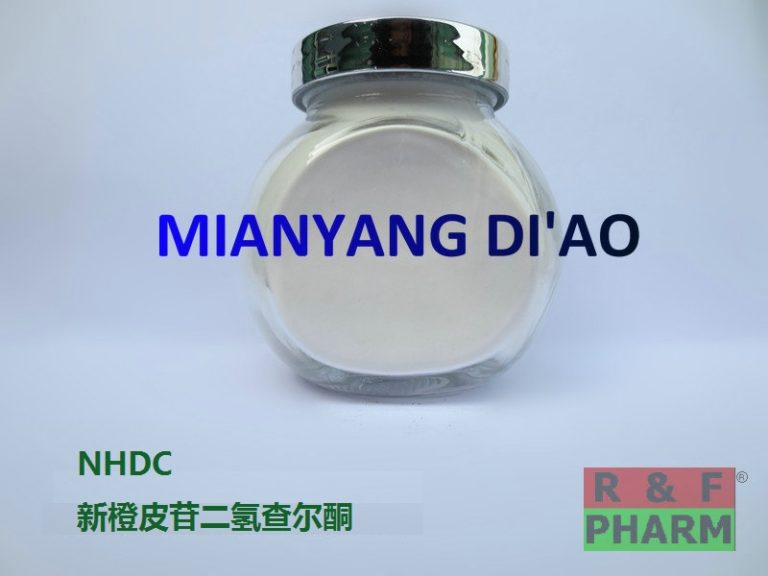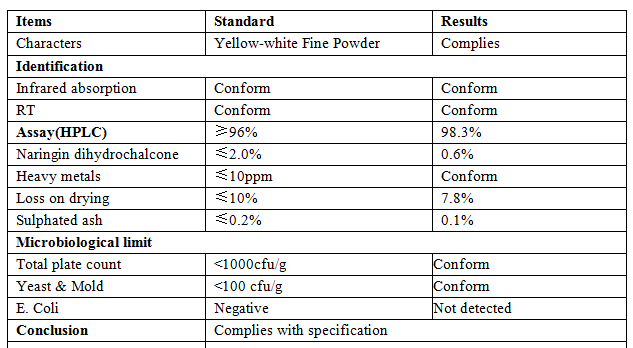Products
Neohesperidin Dihydrochalcone


Neohesperidin dihydrochalcone (Neo-DHC) is synthesized by chemical treatment of Neohesperidin dihydrochalcone, a bitter component of bitter orange, grapefruit, and other citrus fruit peel and pulp. Although it is derived from a natural source, it has undergone chemical transformations, so it is not a natural product. Neo-DHC does not occur in nature.
Neohesperidin dihydrochalcone is up to 1000 times as sweet as sucrose, but it has a number of other properties that limit its use as a sweetener. First, it has an intense cooling effect on the tongue. Second, it has licorice-like and bitter off-tastes. Third, it is slow in onset and has a lingering taste that make it decidedly not sucrose-like.
The concentration vs. response relationship in water is shown below (results in food systems will vary). This graph is based on data from DuBois, Walters, Schiffman, Warwick, Booth, Pecore, Gibes, Carr & Brands in “Sweeteners: Discovery, Molecular Design, and Chemoreception,” D.E. Walters et al., Eds., American Chemical Society, 1991. The units of R are percent sucrose equivalent; the units of C are parts per million (ppm).
Neohesperidin dihydrochalcone functions to mask bitter taste in citrus, and it can enhance the sweetness of other sweeteners. Neohesperidin dihydrochalcone has also been used to mask bitterness in pharmaceuticals.
Neohesperidin dihydrochalcone, sometimes abbreviated to Neohesperidin DC or NHDC, is a sweet substance of molecular weight 612.6 produced by alkaline hydrogenation (treatment with potassium hydroxide or another strong base, and then catalytic hydrogenation) of Neohesperidin, which is a such bitter compound that can be isolated from the peel and pulp of orange, grapefruit, and other citrus fruit. It is a flavonoid and in pure form is found as an odorless white to pale yellow substance not unlike powdered sugar.
Neohesperidin dihydrochalcone is commonly known as a non-nutritive sweetener and artificial sweetener approved for use in the European Union, but not approved by the FDA (so it can’t be used in the United States). Its potency as an intensive sweetener is naturally affected by such factors as the application it is used for and the pH of the product, however aqueous solutions of 0.0045% NHDC and 5% sucrose are approximately equisweet.
Neohesperidin dihydrochalcone has also the characteristics of a taste enhancer, so its addition to other sweeteners, such as saccharin, cyclamate and acesulfame-K increases the total perceived taste intensity of the mixture beyond the level predicted by the combination of the two substances.
Neohesperidin dihydrochalcone was first prepared by Horowitz and Gentili in 1963 as part of a United States Department of Agriculture research program to find methods for minimizing the taste of bitter flavorants in citrus juices.
Antioxidant Properties
In more recent studies Neohesperidin dihydrochalcone showed remarkable radical scavenging activity against stable radical and reactive oxygen species (ROS) in concentration dependent manner. Especially, NHDC was the most potent inhibitor of H2O2 and HOCl. It showed HOCl scavenging activity of 93.5% and H2O2 scavenging property of 73.5%. Moreover, NHDC could inhibit protein degradation, plasmid DNA strand cleavage and HIT-T15, HUVEC cell death from HOCl attack.
NHDC’s antioxidant activity is different against the different radicals:
Stable Radical (·ABTS+): using the Trolox equivalent antioxidant capacity (TEAC), it has an antioxidant activity greater than Trolox, showing that dihydrochalcone compounds have strong hydrogen donation capacity.
